FRANKFURT | CASABLANCA | ROAD TO FEZ | FEZ | ROAD TO ERFOUD | ONWARD TO OUARZAZATE | ROAD TO MARRAKECH | MARRAKECH | TUNISIA | CARTHAGE | DOUGGA/BULLA REGIA | DUBAI | AL MAHA | OMAN | SALALAH |
SALALAHSalalah, in southern Oman, is on the seashore of what the locals call the Arabian Sea but what Rand McNally, among others, call the Indian Ocean.When we arrived in the Salalah airport we stood around with no driver in sight. Part of our travel deal is that we are met at every airport. There are two "five star" hotels in Salalah, and we were staying in one of them. With no one there to meet us, we got on the bus for our hotel. Just before we took off, the car from our travel agency showed up. He said he was late because he just returned from the desert and had to wash his car. He talked non-stop to the hotel, in remarkably good English, but our guide for the afternoon was his cousin. I am fond of saying that my idea of camping is the Hilton. Never was that expression more accurate than here at the Hilton Salalah. It is a businessman's hotel and way far from the City. It is also within sight of a huge, active container ship facility and a large cement factory and a flour mill. The lights and the shipping activity are interesting, especially at night, and happily we don't see either the mill or the cement factory. Besides the Hilton, the other "five star" hotel is the Crowne Plaza, a little more central to the city but apparently not as good in service. Even assuming these hotels have stars at all, it is certainly not clear who gives out them out (it clearly isn't Michelin). Our guide, a cousin of the man who picked us up at the airport, was a stitch. He drove like he was on a wild horse, talked all the time, stopped during the tour to give his mother (who tends a large goat herd) a couple of bottles of water, and generally gave us the most personable, interesting tour we have had in Oman. The other noticeable difference is that both the driver and the guide are native Bedouins, not from Sri Lanka or India, and so have a deep knowledge and love of their homeland. 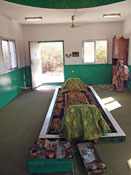 The first part of the afternoon tour was a visit to the mountain region immediately behind Shalalah. Before getting into those mountains, there is a flat area honeycombed with little palm-thatched food stands and mounds. The stands are to service the hoards of people who come from all over the Middle East to visit Shalalah during the monsoons. These visitors like to be in Salalah when it is foggy and rainy (from June until September). We spend weeks trying to plan a tour that is least likely to have rain as a feature, while the Saudis, Egyptians, and other Middle Easterners purposely take a vacation to be in the rain and fog! The mounds turned out to be termite mounds. They aren't as large as those we saw in Australia, but large nonetheless, and they don't seem to bother anyone in the food stands. The first part of the afternoon tour was a visit to the mountain region immediately behind Shalalah. Before getting into those mountains, there is a flat area honeycombed with little palm-thatched food stands and mounds. The stands are to service the hoards of people who come from all over the Middle East to visit Shalalah during the monsoons. These visitors like to be in Salalah when it is foggy and rainy (from June until September). We spend weeks trying to plan a tour that is least likely to have rain as a feature, while the Saudis, Egyptians, and other Middle Easterners purposely take a vacation to be in the rain and fog! The mounds turned out to be termite mounds. They aren't as large as those we saw in Australia, but large nonetheless, and they don't seem to bother anyone in the food stands.
The trip into the mountains was to show us the both the "cowboys" of Salalah and the purported tomb of Job (as in patience of), a prophet who figures large in the Christian, Jewish, and Muslim religions. The grave was quite long, about nine or ten feet. The tomb is shown in the picture, above. 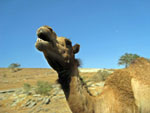 We then threaded our way back down the mountain. I use the word threaded because the road was apt to be blocked or at least occupied by groups of camels or lots of cows. But there was not a cowboy in sight. The herds seem to think the roadways are their right of way, and they are more or less right. But meanwhile the people who lived on the mountaintop enjoyed a generally cooler environment that down by the beach. In addition, what was so arid and dry in the valleys and in the mountains this time of year becomes lush green during and right after the monsoons. We then threaded our way back down the mountain. I use the word threaded because the road was apt to be blocked or at least occupied by groups of camels or lots of cows. But there was not a cowboy in sight. The herds seem to think the roadways are their right of way, and they are more or less right. But meanwhile the people who lived on the mountaintop enjoyed a generally cooler environment that down by the beach. In addition, what was so arid and dry in the valleys and in the mountains this time of year becomes lush green during and right after the monsoons.
We visited a frankincense museum and a local market that sold it. 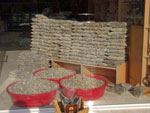 Frankincense was the principal export of the area for centuries (before they discovered oil) and has multiple uses including burning as incense, medicinal uses, and at certain times, as an equivalent of money. At one point it was called "white gold" because it was weighed out against and had the same value as gold. Like rubber and maple syrup, it is a tree sap. It burns with a heavy odor, which we could smell not only in the souks but also in our hotel in Muscat (the Hilton doesn't have it). These days frankincense is brought down from the mountains, sorted in the local markets and shipped all over the eastern world. Frankincense was the principal export of the area for centuries (before they discovered oil) and has multiple uses including burning as incense, medicinal uses, and at certain times, as an equivalent of money. At one point it was called "white gold" because it was weighed out against and had the same value as gold. Like rubber and maple syrup, it is a tree sap. It burns with a heavy odor, which we could smell not only in the souks but also in our hotel in Muscat (the Hilton doesn't have it). These days frankincense is brought down from the mountains, sorted in the local markets and shipped all over the eastern world.
We went to old and new parts of Salalah - remember that the 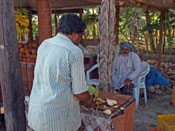 cities in this part of the world went from completely undeveloped Bedouin encampments to urban centers in the span of thirty years or less. Omani cities are still integrated with the old farming communities. For example, Shalalah has a very tropical environment, growing coconuts, papayas, and bananas. (In fact, it is so tropical that dates do not grow here, it's too humid. Dates need really, really dry conditions.) Outside the many large plantations that sit side by side with residential areas in Salalah, you can buy the coconuts, papayas and bananas from roadside stands. We stopped at one, where the shopkeeper opened up a coconut with what had to be the sharpest knife/cleaver on the planet and we sampled coconut milk and the top, tender layer of coconut meat. cities in this part of the world went from completely undeveloped Bedouin encampments to urban centers in the span of thirty years or less. Omani cities are still integrated with the old farming communities. For example, Shalalah has a very tropical environment, growing coconuts, papayas, and bananas. (In fact, it is so tropical that dates do not grow here, it's too humid. Dates need really, really dry conditions.) Outside the many large plantations that sit side by side with residential areas in Salalah, you can buy the coconuts, papayas and bananas from roadside stands. We stopped at one, where the shopkeeper opened up a coconut with what had to be the sharpest knife/cleaver on the planet and we sampled coconut milk and the top, tender layer of coconut meat.
MORE SALALAH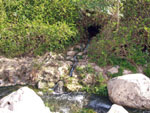 Today was the busiest day of the whole trip. We started with a visit to an area of natural springs coming out of the base of a tall hill. The small springs together formed a pretty mountain stream. This is a stream that could be anywhere in the Eastern US but is a major tourist attraction in the desert country of Oman. Tourists can enjoy about 1,000 feet of it, and then the water is taken off to irrigate some of the Sultan's own farms. Today was the busiest day of the whole trip. We started with a visit to an area of natural springs coming out of the base of a tall hill. The small springs together formed a pretty mountain stream. This is a stream that could be anywhere in the Eastern US but is a major tourist attraction in the desert country of Oman. Tourists can enjoy about 1,000 feet of it, and then the water is taken off to irrigate some of the Sultan's own farms.
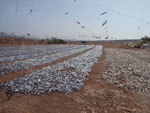 From there we drove to a place that dried sardines, not for human consumption but for livestock. This is a way to get some salt into their diet. Talk about recycling: to keep the seagulls off the drying fish, the fishermen tie discarded plastic bags on long strings just above the fish. It was colorful and a win-win for the fishermen and the environment. We then stopped at an overlook and saw an old town and fishing boats. It is hard to imagine the miles and miles of seashore that have wide beautiful beaches and no people. If there were people on the beach at all, they were the local fishermen. From there we drove to a place that dried sardines, not for human consumption but for livestock. This is a way to get some salt into their diet. Talk about recycling: to keep the seagulls off the drying fish, the fishermen tie discarded plastic bags on long strings just above the fish. It was colorful and a win-win for the fishermen and the environment. We then stopped at an overlook and saw an old town and fishing boats. It is hard to imagine the miles and miles of seashore that have wide beautiful beaches and no people. If there were people on the beach at all, they were the local fishermen.
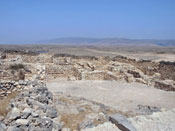 The next stop was an ancient frankincense town where the Queen of Sheba (a Yemeni) was said to have stopped to get the best quality frankincense to take as a gift to King Solomon as a gift. Frankincense was literally worth its weight in gold in past centuries and was called the "white gold". It was not until the Seventies when oil was discovered ("black gold"), that it was replaced as the major source of trade income. The next stop was an ancient frankincense town where the Queen of Sheba (a Yemeni) was said to have stopped to get the best quality frankincense to take as a gift to King Solomon as a gift. Frankincense was literally worth its weight in gold in past centuries and was called the "white gold". It was not until the Seventies when oil was discovered ("black gold"), that it was replaced as the major source of trade income.
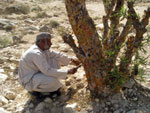 Later in the day, the guide took us into a rocky gully he knew about to show us frankincense trees and to demonstrate how the trees were cut (in a way reminiscent of maple sap harvesting). The tree, as it tries to heal itself, produces the sap that is frankincense. Later in the day, the guide took us into a rocky gully he knew about to show us frankincense trees and to demonstrate how the trees were cut (in a way reminiscent of maple sap harvesting). The tree, as it tries to heal itself, produces the sap that is frankincense.
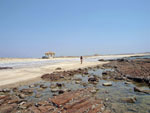 We stopped for lunch in a deserted stretch of beach. The government builds cabanas on the beach for the citizens to picnic in. We had ours all to ourselves. There was a coral reef nearby where we went hiking at the low tide. In addition to all of the other sea life, there were beds of oysters on the coral. We stopped for lunch in a deserted stretch of beach. The government builds cabanas on the beach for the citizens to picnic in. We had ours all to ourselves. There was a coral reef nearby where we went hiking at the low tide. In addition to all of the other sea life, there were beds of oysters on the coral.
We then drove to the west of Salalah to see some natural blowholes along the coast twenty miles or so from the city. Again, the scenery in the mountains as we drove there was breathtaking, like high desert in our Southwest, and the seashore where the blowholes were, deserted. As an aside, most of these sites were developed recently by the government. They are well maintained but eerily vacant of tourists - not that we are complaining. Our trip, as least the tourist portion closes here. Today's tour was a wonderful capstone to a busy three weeks. We board a plane tomorrow for Dubai, stay at a hotel for about six hours, fly to Frankfurt, lay over for a few hours and continue flying to DC. By the time we finally get back to Bethesda we will need a transfusion. Then we'll need another transfusion after we add up the total number of pictures we've taken. |
|
| TURKEY AND GREECE | CIRCLE THE ARCTIC |